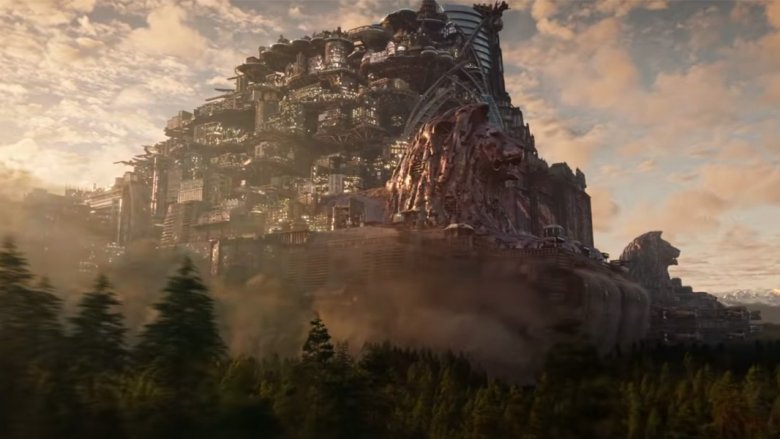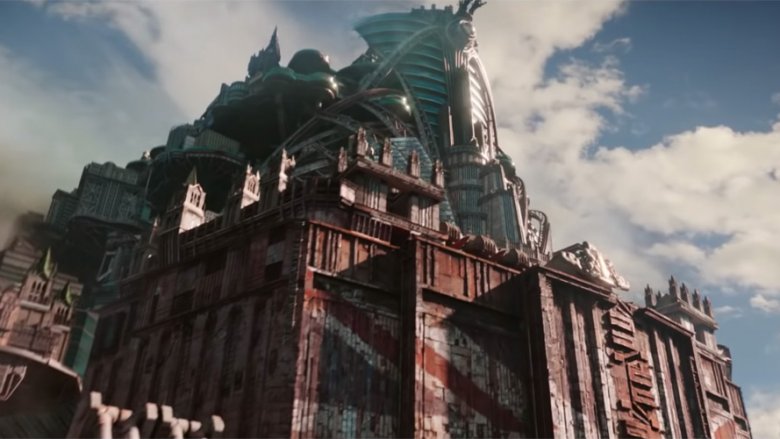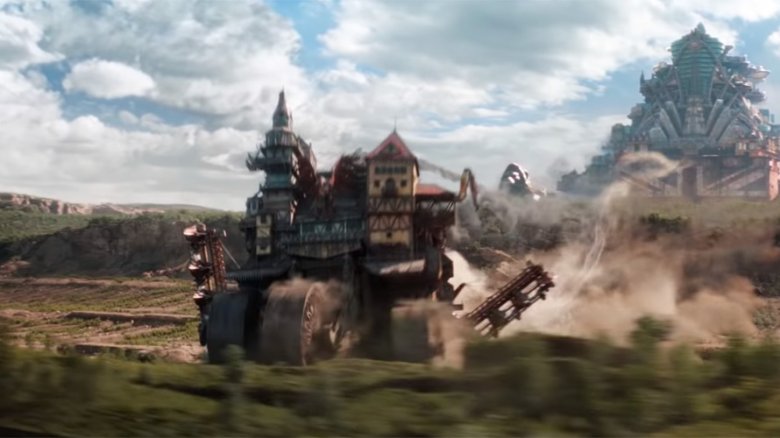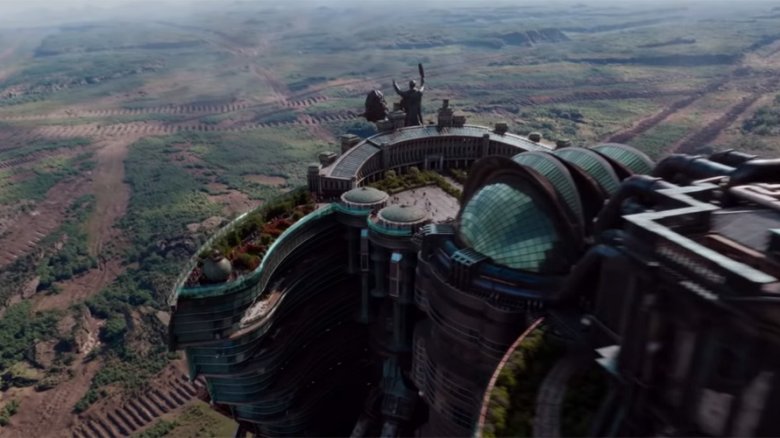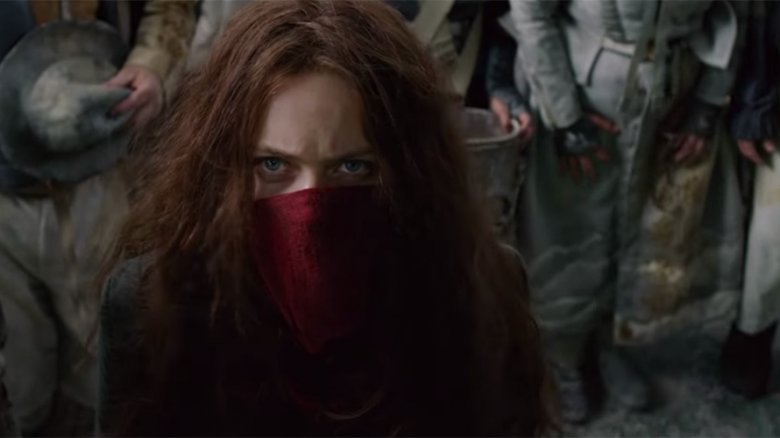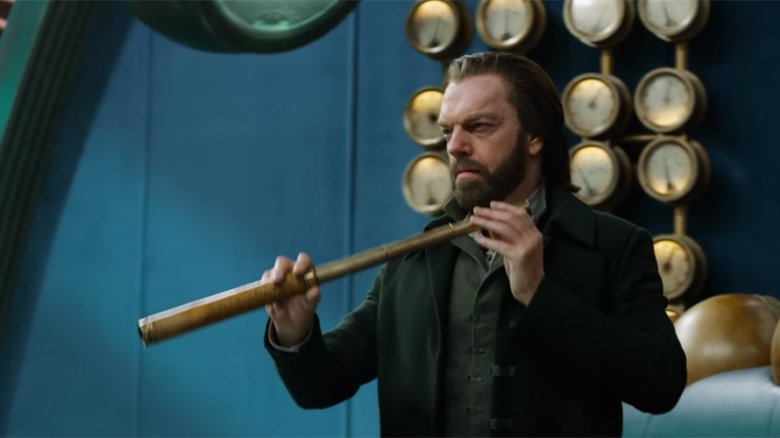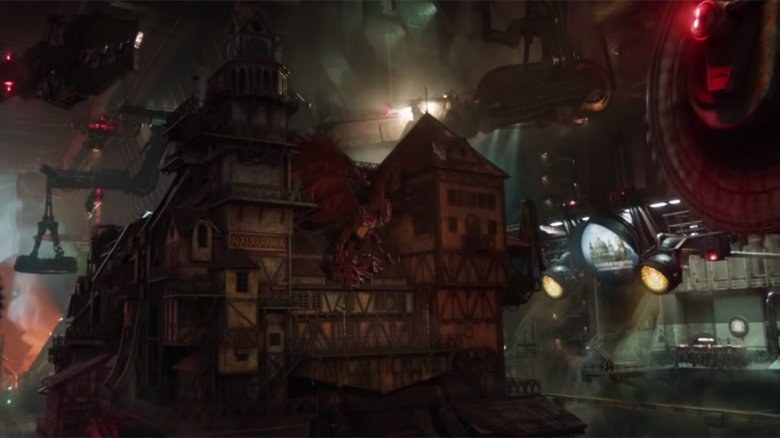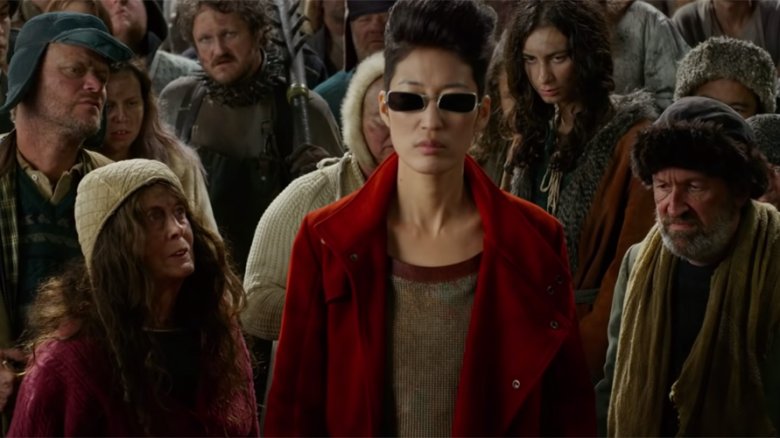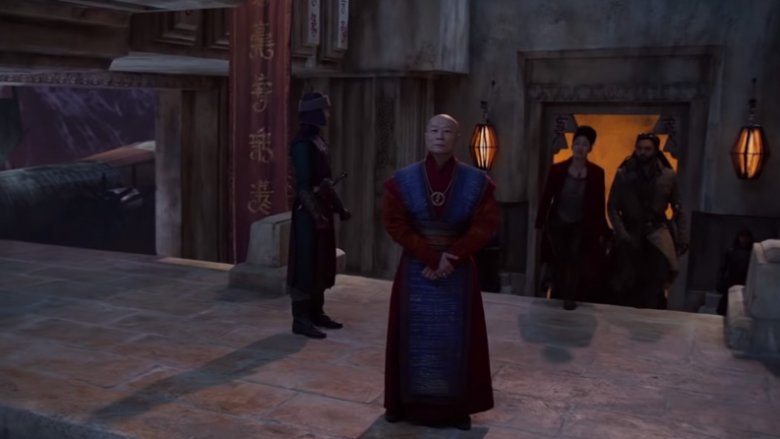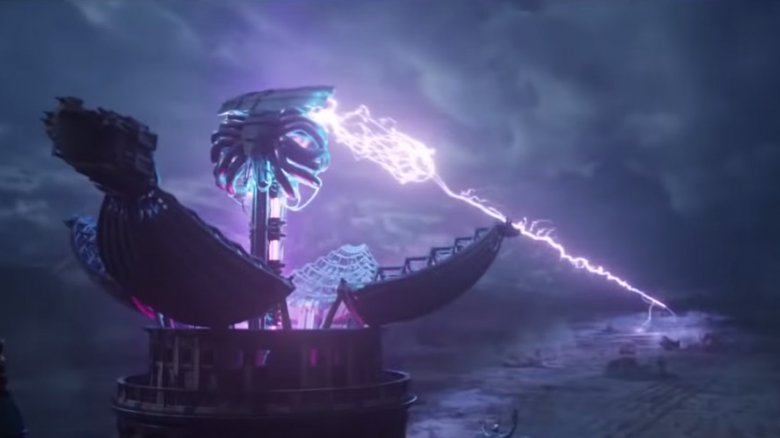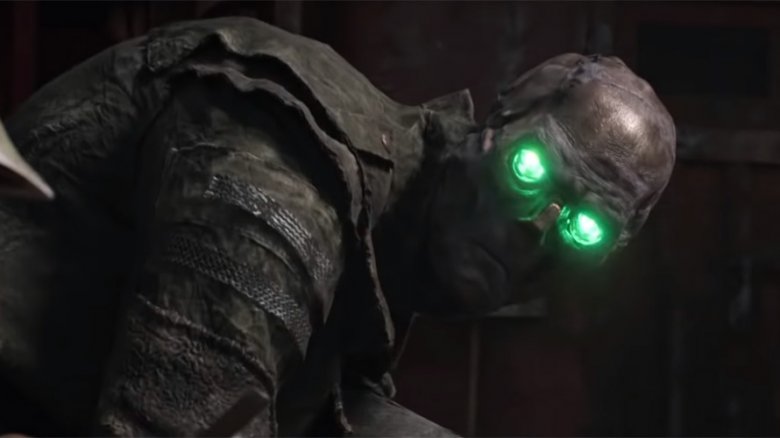10 Reasons Mortal Engines Was The Dumbest Movie Of 2018
A great film is always fun to watch, but every now and then, a movie hits the screen that's so uproariously stupid that it somehow loops back around to being phenomenally entertaining. In 2018, a year that was otherwise marked by cinematic high points in virtually every genre, that movie was Mortal Engines.
Based on the series of young adult novels by Philip Reeves, Mortal Engines is the story of a post-apocalyptic world where the devastating 60-Minute War obliterated society as we know it, and led to the remnants of civilization deciding that they should convert their cities to massive mobile tanks that ate smaller cities for fuel in a process referred to as "Municipal Darwinism." It's exactly as ridiculous as it sounds, but in case you need further proof that it's the best bad movie to come along in a while, here are ten reasons why Mortal Engines was the single dumbest movie of 2018.
What if city was tank?
It cannot be stressed enough that Mortal Engines is built entirely around the premise of cities that have been converted to gigantic, massive tanks called "traction cities" that roam the land in search of resources and forgotten technology from the pre-apocalyptic world. Just to be clear, these aren't city-sized tanks, either — they're full-on cities, complete with buildings, marketplaces, and skylines, right down to recognizable landmarks like St. Paul's Cathedral, which sits at the top of the now-mobile London and will eventually be the home of a doomsday weapon. More on that in a moment.
This is, by any standard, an extremely goofy premise. That's not necessarily a bad thing, though — plenty of great movies are rooted in silly ideas. One of the biggest franchises of all time pretty much boils down to space wizards poking at each other with laser swords, and 2018's biggest blockbuster was the story of a giant purple spaceman using a magic glove to fight a tree, a sad robot, and a man in a very cool kitty cat costume. Describe it in those terms, and Infinity War sounds like a fever dream, but you'd be hard pressed to find moviegoers who thought that inherent goofiness did anything to keep it from being awesome.
At the same time, the fact that Mortal Engines is starting with the idea that the city of London is now a cannibalistic tank doesn't do it any favors once it starts layering everything else on top of it.
Eat more cities!
Believe it or not, the single biggest problem with the premise of Mortal Engines might just be that it doesn't go far enough. After asking its audience to buy into a world where London is the apex predator of "Municipal Darwinism," the film doesn't actually do a lot with that idea. The only time we really see that concept in action comes at the beginning, when London devours a small Bavarian mining town that looks like a Renaissance faire mounted on top of a dune buggy. That's it.
Admittedly, that's part of the premise — the villain's plot is driven by the idea that the wasteland that used to be Western Europe has been depopulated over time by the traction city equivalent of overfeeding. It's worth noting that rather than recognizing this as an inherent flaw of a system where monster truck cities eat each other and leave nothing behind, London's ruling class instead decides that they need to pillage a new continent that, from everything we've seen in the movie, is made up of regular, non-mobile cities. That's easy to forgive, since the villains of the movie need to act villainous and all that, but when the plot of your story by its very nature raises questions about the premise, it makes it much more difficult to accept all that wackiness that everything is resting on.
The soaring design of London as a monster truck
Given that we've already discussed the inherent silliness of the plot and the movie's trouble living up to it, it would be easy to believe that the visuals of Mortal Engines would have a similarly hard time conveying the appeal of this world. The weird thing is, they don't. Not at all.
In fact, Mortal Engines is a beautifully designed film. As goofy as the core idea of "traction cities" might be, the visuals of the movie sell the concept perfectly. London itself is fascinating to look at, this towering, mobile fortress capped off with a ruined St. Paul's Cathedral as a signifier of the destruction suffered in the apocalyptic 60-Minute War. The massive roaring lions mounted at the front of the city — the famous statues from Trafalgar Square scaled up to Kaiju size in line with the city — the battle-scarred Union Jack that slides open to reveal London's all-consuming maw, the plazas (complete with windshields) where the citizens cheer on the destruction of rival cities like they're watching a World Cup qualifier? All of that stuff looks great.
Just going by the visuals, you'd have no problem believing that Peter Jackson was a producer on the film. Unfortunately, when they're contrasted with the rest of the movie's flaws, those breathtaking visuals only really serve to remind viewers that this movie could be a lot better than it actually is.
The Good, the Bad, and the... Mostly Bad
In all fairness, the visuals aren't the only good part of Mortal Engines by a long shot. The movie actually has a whole lot going for it. The problem is that everything that's good about it is balanced out, or even negated, by a problem.
The acting, for instance, is pretty great across the board. Hugo Weaving brings his typically menacing edge that keeps him from being entirely reduced to a scenery chewing villain, and Hera Hilmar is extremely compelling as Hester Shaw, the lead character who's out for revenge against him. The problem is that all that good acting is in spite of the material that they're given, which winds up serving the same disappointing end as the beautiful design elements.
Those good elements, though, are what make Mortal Engines so relentlessly watchable as a bad movie. No one's phoning it in here — everyone involved is putting in their best effort to elevate the material, and weirdly enough, that makes Mortal Engines come off as the movie that would happen if Miami Connection or The Room had a budget of $100 million.
Moustache-twirling villainy
On the subject of Hugo Weaving, it's worth mentioning that his character, Thaddeus Valentine, has exactly one trait, and it is Capital-E Evil.
That is, of course, to be expected, since dystopian post-apocalyptic societies are usually not run by kindly, benevolent scientists, although at this point that might actually be the only way to get around the inherent cliches of the genre. Valentine, however, takes that to the extreme: his entire motivation is to take control of a doomsday weapon so that he can kill the largest possible amount of people in his goal of feeding all of Asia to London, piece by piece, rather than, say, engaging in trade with what by all accounts appears to be a prospering civilization that also has gigantic guns aimed westward.
There's probably a metaphor for colonialism in there somewhere — it would be hard to miss when the entire story focuses on the city/tank that was the capital of one of history's largest colonial empires, even if the wardrobe styling wasn't deliberately Victorian — but it's all muddled up in truly cartoonish ruthlessness. Valentine is the kind of villain who commits mass murder on the mere suggestion that someone might uncover hints of his evil past, or his genocidal plan... which he unveils to the approval of a cheering crowd. This, in turn, raises the question of why he had to keep it so secret if everyone was down with all his murders anyway.
Also? It turns out he's actually really bad at being a villain, since his go-to murder tactic involves kicking someone into what is basically a large and fun-looking slide from which London poops its excess building material. No, seriously.
Why do the good guys have genocide weapons though?
As for the person who gets kicked down London's easily survivable poop slide, that would be Tom Natsworthy, our male lead. He's a historian, and also the entire reason that Hugo Weaving is able to build his genocide laser. See, it turns out that Tom has been secretly stockpiling pieces of the extremely dangerous old technology that ended the world thousands of years before.
It is explicitly stated in the movie that he's only hanging onto it until he has a chance to destroy it, but it's not explained why he would need to wait to do so, especially when there's a massive city-eating furnace with so many actual chainsaw blades and crushing pistons that make it seem like London might have been designed by Dr. Wily. Then again, if he did just chuck all the armageddon chips in there, we wouldn't have the chance to get a plot driven by the search for our mandatory McGuffin: a USB flash drive that can immediately destroy the quantum laser when you put it into a computer and, one assumes, scroll through all the terms and conditions of the End User License Agreement for doomsday devices.
Once again: no, really. That is the plot. This movie has a runtime of two hours and eight minutes, and most of that is devoted to people looking for a flash drive.
Deus ex city-tank
Rounding out our cast of heroic characters is Anna Fang, an anti-traction-city terrorist/freedom fighter whose costuming makes her look like she's doing a really great job of cosplaying as Travis Touchdown from No More Heroes. She's introduced very early on as an enemy of the state (or city... or tank), and later appears as an unvarnished deus ex machina, saving Hester and Tom from being sold into slavery in the scene where Mortal Engines gets its most Mad Max.
More than any other character in the film, Anna exists as a plot contrivance. She literally ferries the main characters from one set piece to the next on multiple occasions, while offering up exposition and crucial background information. Her own backstory is mentioned, but her actual motivations are never explored. Instead, she's sort of reduced to a caricature of a Han Solo type, except for the parts where Han is fallible and likable — and if you like comparisons to Star Wars, buckle up, friends, because we're getting there.
It's worth noting that while (spoiler warning) Anna dies at the climax of the film, she's actually brought back in the novels as a zombie robot that tries to take over the world. So, you know, on the off chance that Mortal Engines gets a sequel, we have that bit of buck wild nonsense to look forward to.
The ultimate battle: City vs. Wall (and 2018 vs. Orientalism)
For the climactic action scene of Mortal Engines, a movie based entirely around the idea of giant mobile cities fighting and eating each other in huge-scale pirate battles, the filmmakers decided instead to pit the city of London against another foe: a wall. Like... a big wall.
This, of course, is the same sort of ultimate battle of unstoppable force vs. immovable object that made WrestleMania III such a memorable classic, but despite some genuinely nice visual touches — the approach to the wall is littered with the skeleton-like ruins of other cities that tried to breach it — it's fair to say that it lacks the tension that a climactic battle should have. Part of that is because at this point, the movie has indulged in so many cliches that the end isn't even a shred in doubt, but the much larger problem is the truly insane level of pulp novel-style Orientalism running through the whole thing.
If the imagery of Asia being protected by a really great wall was a little too subtle for you, Mortal Engines is happy to present the residents of the land beyond the wall as inscrutable zen masters who wear Kung Fu movie monks' robes and Kurosawa samurai armor and embrace the impermanence of all things, nobly forgiving their fallen foes once London is defeated. Of all the visual and cultural nods to Victorian England that the movie lifted to make its points, maybe its attitude to the "Mysterious East" should've been left there.
I have a bad feeling about this...
And now we get to the most hilariously egregious of Mortal Engines' many, many sins. Remember earlier, when we mentioned comparisons to Star Wars? There's a reason you're going to want to keep that film in mind if you ever watch this one (and you should). At the end of Mortal Engines, they just straight up do the endings of all three original Star Wars movies. In order. Without even changing them up.
First, of course, is the Death Star run from Star Wars. In this case, that's represented by a squadron of plucky young pilots, including the naive young man that we've been following for the entire movie as he joined this rebellion against British-accented evil guys and their hugely destructive laser weapon. It hits the same beats, including other, less plot-relevant pilots sacrificing their lives and exploding against the surface of the Death St — er, London. Then, a bit later, we get a second Death Star run, only this time it takes place inside London, with Tom trying to blow up the city's (mortal) engine from within. The imagery is so reminiscent of Lando blowing up the second Death Star in Return of the Jedi that it can't be anything but intentional. They have to know what they're doing — they used "join the Rebellion" as a tagline in the trailers!
Sandwiched between those, of course, we have Mortal Engines' take on The Empire Strikes Back, in which it is revealed that Thaddeus Valentine is — gasp — actually Hester's father! There's even an "Obi-Wan never told you" moment, switched around to be about Hester's mom. To its credit, it is jaw-droppingly bold to rip off the ending of not just Star Wars, but the entire original trilogy, and hope that nobody will notice. But jeez, Mortal Engines. Even when you're copying someone's homework, you want to change a couple of answers so that it's not so obvious, and math class is significantly less famous than Star Wars.
I am also your father!
The best part of Mortal Engines ripping off Star Wars is that Thaddeus Valentine revealing that he's Hester's father is actually the movie's second evil dad reveal. Even better? It's the second evil dad reveal for the same character.
Earlier in the film, Valentine unleashes Shrike, an unstoppable (until he isn't) Terminator-style robot devoted entirely to killing Hester. Later, it's revealed that once her mother was murdered, Hester was found by Shrike, who raised her as a daughter and taught her how to stab people, and that he only wants to kill her because she promised he could also turn her into a zombie robot. That's amazing for several reasons, including the fact that it makes "London is a tank now" seem like a completely reasonable plot point by comparison. Seriously, props to Mortal Engines for doing "evil guy is actually the heroine's father" twice in one movie.
Also, speaking of evil dads, there's a scene where Valentine's other daughter, Katherine (who never actually contributes to the plot), climbs up a secret passageway made up of a thousand stairs in order to secretly enter the bad guys' evil lab, and then she leaves and then just walks back in through the front door. That's bad, but compared to the rest of the movie, it's just regular bad.
